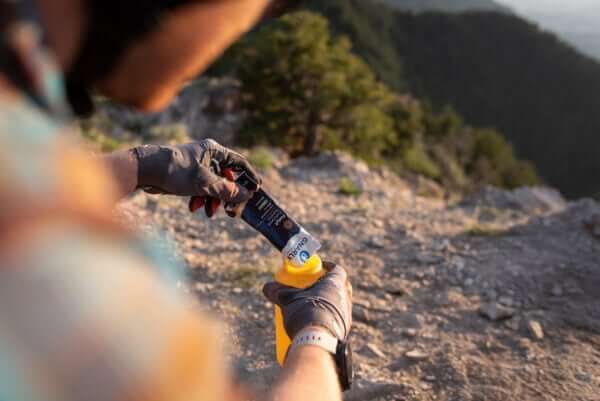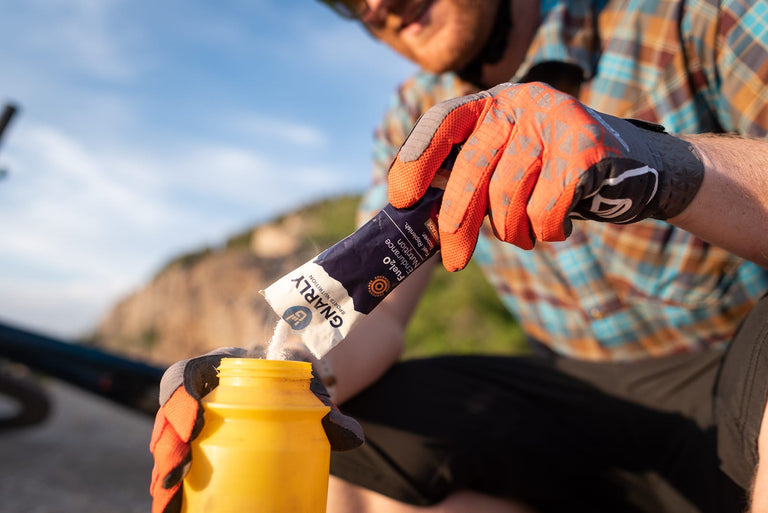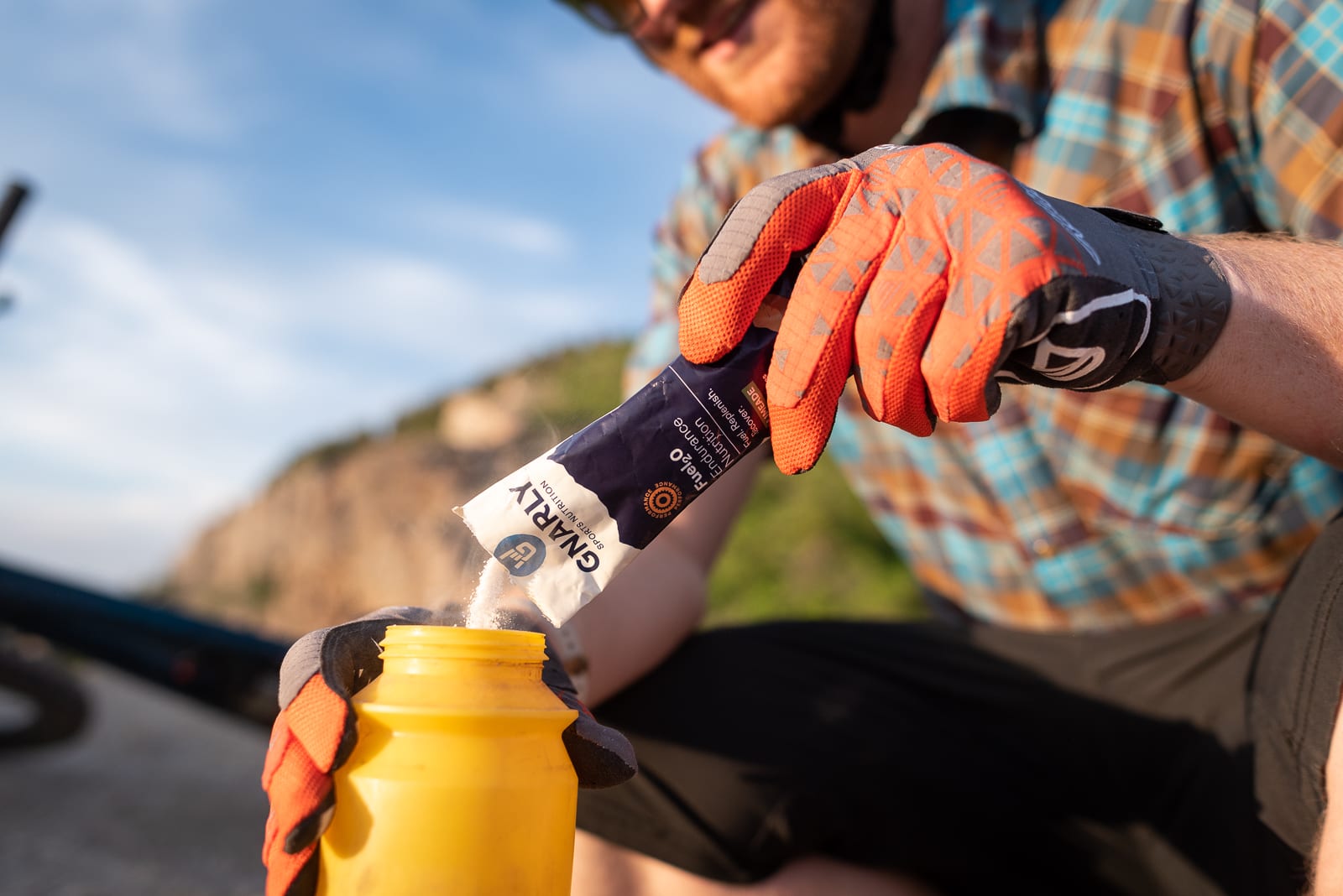"Running is an eating contest on the go"
Nutrition is an essential and often overlooked part of endurance training. No matter what kind of periodization you are doing, how often you do hill repeats or how fast your tempo workouts are, if you don’t dial in your nutrition, none of that hard work will matter. All other things being equal, the person that can get in enough calories, hydrate effectively and keep electrolytes where they need to be will win the day. But often, managing all of these things over the long run can be difficult and cumbersome.
Enter Gnarly’s newest product, Fuel2O a streamlined endurance nutrition solution. Created with fueling, replenishment and recovery in mind, Fuel2O is the all-in-one, vegan-friendly solution for long days on the trails, in the mountains, at the gym or the crag.

Fueling
Getting in enough calories while endurance running or biking can often be an ‘uphill battle’ (pun intended), with both carbohydrate and fat serving as important fuel sources for longer efforts. The relative use of carbohydrate vs. fat can be dependent on a number of factors including gender, diet, intensity, effort, and training status, but when performance and exercise capacity are on the line, carbohydrate intake is critical, and like many things, easier said than done.

On average, an individual burns ~500-700 calories per hour when running or biking at a moderate pace. That same individual can only effectively process ~60g (240 calories) from a single carbohydrate source in that hour, leaving a substantial hourly caloric deficit that multiplies with every hour spent exercising.
Why the limit on carbohydrate use? Well, when carbohydrate intake comes from a single source (i.e. glucose), the protein responsible for transporting glucose from our gut into our circulation becomes saturated right around an intake of 60g/hr, limiting our ability to oxidize or ‘use’ greater amounts.
This is where the idea of multiple transportable carbohydrates comes into play: instead of using just one carbohydrate source, we use a combination of carbohydrates (glucose and fructose) that use different transport proteins, allowing us to bypass the saturation bottleneck and use greater total amounts of carbohydrates with a low risk of GI distress. Using two carbohydrate sources increases the amount of carbohydrates we can use on an hourly basis from 60g to 90g (360 calories) – a fairly significant gain!
Fuel2O uses a combination of the monosaccharide glucose (made up of glucose and fructose) and the disaccharide sucrose (made up of sucrose and fructose) to do just this. At 25g of carbohydrates/12 oz, a single serving of Gnarly Fuel2O is a great option for fueling efforts <90 minutes. For longer training or racing days, especially those >> 3 hrs, 2-3 scoops of Gnarly Fuel2O/24oz of water will deliver 50-75g of carbohydrate (200-300 calories) with a low risk of gut distress.
Replenishment
Dialing in your hydration and electrolyte needs is equally as important as fueling during big days out in the hills. There is a huge amount of variation within and among individuals in both water and electrolyte loss. Factors impacting sweat rate and sweat electrolyte concentration include genetics, diet, environment, intensity, duration and acclimatization.
A good first step, and something you can do at home, is to determine your sweat rate or the amount of water lost via sweat in a given amount of time (typically an hour). For the specifics on how to effectively do a sweat test, visit Gnarly’s Hydration & Sweat Test. When measuring sweat rate, it’s important to replicate the conditions you will experience on race day as closely as possible and to realize that it may be necessary to do this kind of test often as factors like season and fitness change can affect results.
Determining the amount of electrolytes lost in sweat requires an electrolyte test, which can be administered and analyzed in performance labs. Much like sweat rate, the electrolyte content of sweat is dependent on many factors and can vary greatly from person to person. Although a variety of electrolytes are lost in sweat, sodium loss should be the greatest focus given it is the electrolyte lost in the greatest quantities and has the most significant impact on body fluid balance. Sodium losses in sweat range from 200-700mg per 16 oz of sweat. By choosing a hydration beverage that contains electrolytes at effective levels, you ensure you’re giving your body both the water and electrolytes it needs to perform optimally, while helping to reduce the risk of cramping and dehydration.
It's endurance insurance

Fuel2O contains sodium, magnesium, potassium, chloride and calcium. A single serving of Gnarly Fuel2O contains 250mg of sodium/12oz and is a great option for training bouts that last less than 90 minutes. For efforts significantly over 90 minutes and/or training in extreme conditions, 2-3 scoops of Gnarly Fuel2O/24oz of water is recommended hourly and will deliver 500-750 mg of sodium.
Recovery
Endurance exercise, particularly ultra length races, result in a prolonged caloric deficit that compounds the impact of exercise on muscle damage and muscle protein breakdown (MPB). Muscle damage results in Delayed Onset Muscle Soreness (DOMS), impaired muscular force production and the appearance of muscular proteins in the blood. Translation? It wrecks your recovery and makes it hard to walk down stairs. Research has shown that the inclusion of protein or branched chain amino acids (BCAAs) with carbohydrates during endurance exercise reduces signs of muscle damage more than carbohydrates alone. Translation this time? You will recover better after races and hard training runs. YAY!
Here is where HMB (β-Hydroxy β-Methylbutyrate) comes into the story. HMB is a metabolite of the branched chain amino acid leucine. Approximately 5% of dietary leucine is converted into HMB. When compared to leucine, HMB appears to be significantly more potent on a per weight basis at reducing muscle protein breakdown….20x more potent (!!). This means that significantly less HMB can have a greater effect than leucine on minimizing muscle protein damage and optimizing recovery.
A single serving of Fuel2O contains 280mg of HMB and will help with recovery when efforts may be intense, but of shorter duration. For longer efforts, 2-3 scoops of Gnarly Fuel2O will deliver 560-840mg/24oz and kickstart your recovery by significantly reducing muscle protein breakdown. Think of it like endurance insurance.
Endurance events are tricky beasts and above all else, practicing fuel timing and dialing in your nutrition is essential. Fuel2O was created to help simplify this process by giving you an all-in-one solution that provides easy to digest calories, replaces lost sodium, and optimizes recovery with HMB. Offered in three flavors – Tropical, Limeade and caffeinated Cherry Cola – Gnarly Fuel2O is delicious, lightly flavored and easy to drink. So next time you head out the door for a looong day, add Gnarly Fuel2O to your bottles to push harder for longer, and to bounce back quicker.

References
Baker, Lindsay B. “Sweating rate and sweat sodium concentration in athletes: a review of methodology and intra/interindividual variability.” Sports Medicine 47.1 (2017): 111-128.
Cockburn, Emma, et al. “Acute milk-based protein–CHO supplementation attenuates exercise-induced muscle damage.” Applied physiology, nutrition, and metabolism 33.4 (2008): 775-783.
Greer, Beau Kjerulf, et al. “Branched-chain amino acid supplementation and indicators of muscle damage after endurance exercise.” International journal of sport nutrition and exercise metabolism 17.6 (2007): 595-607.
Hall, Andrew H., et al. “Coingestion of carbohydrate and protein during training reduces training stress and enhances subsequent exercise performance.” Applied Physiology, Nutrition, and Metabolism 38.6 (2013): 597-604.
Jeukendrup, Asker E. “Training the gut for athletes.” Sports Medicine 47.1 (2017): 101-110.
Jeukendrup, Asker E. “Multiple transportable carbohydrates and their benefits.” Sports Sci Exchange 26.108 (2013): 1-5.




